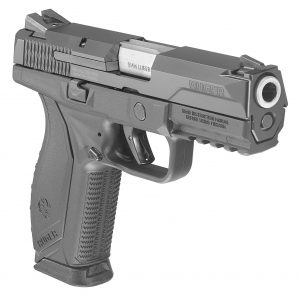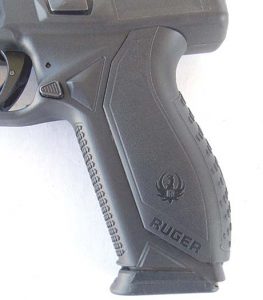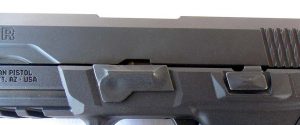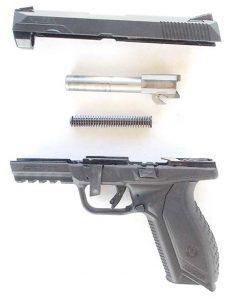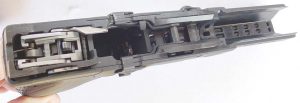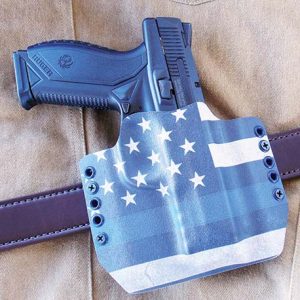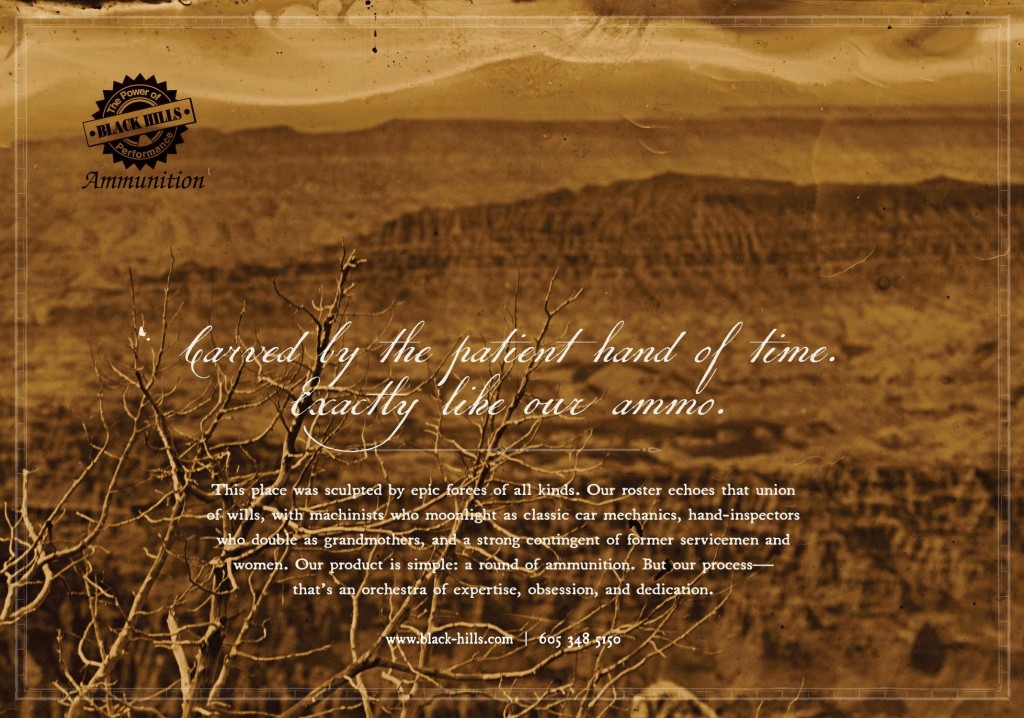by R. K. Campbell | Contributing Editor
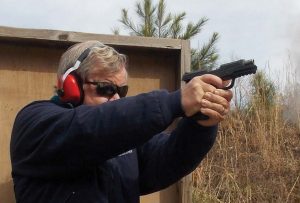
Two cartridge cases are in the air as the Ruger American 9mm cycles. This is not only a controllable handgun but an enjoyable handgun to fire and use.
The polymer frame 9mm field may be crowded but the author believes there is room for innovation. The stakes are high in this market. With a military contract on the horizon, Ruger has set the bar high with their new entry. The Ruger American is the product of years of research and studying the needs of both civilian and institutional buyers. The pistol that was envisioned would incorporate common features that buyers find attractive into the design while offering singular features as well. The price point is important but not difficult to meet with modern manufacturing methods.
Ruger is arguably among the makers with the greatest expertise in manufacturing rugged, reliable and serviceable firearms. Mechanically the new Ruger American isn’t an upgraded member of the SR series—far from it. The American pistol was designed with the US Military’s Joint Combat Pistol competition in mind. The requirements of the military were considered a baseline. With the aging Beretta 92 due for upgrade or replacement, the Ruger American was designed as a contender. The pistol’s design had input from law enforcement experts, trainers, and rank and file. The result is a pistol that is well suited for law enforcement use as well as military. The initial versions are chambered in 9mm Luger and .45 ACP. With the current trend toward a 9mm service pistol rather than the .40, it remains to be seen if a .40 caliber version will be offered. Almost certainly compact versions will follow.
The pistol features the proven Browning locked breech design. Ruger has tweaked the design to alter locking and unlocking for greater reliability. Along the way they have designed a camming surface that makes for less recoil impulse than expected. The effect is most noticeable with +P loads. Since the military trial calls for 124-grain NATO specification loads this is a good engineering step. Another good engineering change compared to many modern handguns is a slide that rides lower in relation to the hand. The result is a lower bore axis and less leverage for muzzle flip. During firing exercises nothing I learned could contradict Ruger’s claims. A 9mm pistol this size should be comfortable to fire; however, the Ruger American is exceptionally comfortable, even with +P loads. Reliability has been faultless and the pistol is nearing 800 rounds of mixed handloads, FMJ, JHP and +P loads without a single failure to feed, chamber, fire and eject.
The slide is pleasing to the eye. It isn’t squared off in the European standard. The cocking serrations are well designed and offer a good grasp when manipulating the slide. The sights are dovetailed in place. The rear sight is adjustable for windage. These are Novak design sights. The Novak Low Mount sight has been the premier combat sight for serious use for decades, and a fine choice for Ruger’s American 9mm. The sights are regulated for 124-grain loads and the 6 o’clock hold. The barrel is good news for high volume 9mm shooters. The six lands and grooves are conventionally rifled. This means that you will be able to use lead bullet handloads, which are prohibited in the Glock pistol. If you practice a lot or shoot 3 Gun competitions, this is welcome news. The pistol is accurate enough for such competitions. My example has proven accurate with the Magnus 122-grain hard cast bullet. The chamber is fully supported, another good thing for handloaders and those that fire +P ammunition.
The Trigger
The action isn’t a double-action-only but a single-action. It feels more like a Springfield XD than the Glock, which isn’t a bad thing. It is similar to the new SIG 320 pistol, but unique at the same time. The striker isn’t prepped as it is with the Glock, demanding that trigger action finish the job of cocking and releasing the trigger. When the slide is racked the striker is fully cocked. The trigger then releases the sear, firing the handgun. There is a firing pin safety and a safety lever in the trigger to prevent lateral discharge. The trigger breaks cleanly at 5.9 pounds after little take-up and with no detectable creep. This is a service grade trigger that doesn’t challenge the novice. An experienced shooter will be able to fire accurately with acclimation to the trigger action. The trigger group is contained in a steel chassis with integral slide rails that ride inside the frame.
Controls are few and include an ambidextrous slide lock, ambidextrous magazine release, and takedown lever. The Ruger American is fully ambidextrous. The magazine release is positive in operation. Shelves on the frame protect the magazine release from inadvertent operation. The slide lock is also protected. The firing grip fits most hands well as issued, but there are modular grip inserts for further adjustment. The maximum difference in trigger reach is .3 with the largest to the smallest grip insert, a significant amount of adjustment. The frame is a combination of stippling, serrations and pebbling that comes off well. The frame features a mount for lights or lasers under the forward portion of the slide. The trigger guard is undercut between the trigger guard and the front strap. This serves to further lower the bore axis. The Ruger American has a pleasant heft and points well.
The magazines are steel with a capacity of 17 rounds. The magazines are a dull gray finish due to a Teflon-based coating. This is a good touch on a service pistol. The frame extends a bit from the magazine well to prevent pinching the hand as you seat the magazine. The tapered magazine is very fast to reload. The .3 inch frame extension houses a lanyard attachment for those interested in using this device.
I like the break down and field strip of the Ruger. First, an advantage over the Glock, is that the trigger doesn’t have to be pressed to disassemble the pistol. Lock the slide to the rear, remove the magazine, and rotate the take down lever downward. Release the slide stop and control the slide’s travel as it runs forward. The recoil rod guide and recoil spring lift out easily; the barrel simply is pressed out of the slide.
Shots fired
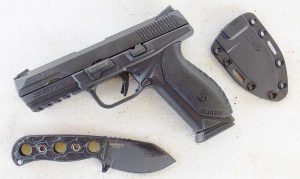
Combined with the CRKT Pangolin, the Ruger American is going to see a lot of use in the author’s ready battery.
During the first few days with the pistol I fired over 300 rounds of cast bullet handloads, full metal jacketed bullet loads, JHP loads of 115, 124 and 147-grain bullet weight, and also +P loads. During the evaluation there were no failures to feed, chamber, fire or eject. The pistol proved reliable with 9mm Luger ammunition even with a deviation of bullet weights and velocity ran from 890 to 1,350 fps. The pistol is fast on target and the Ruger, unlike many polymer pistols, isn’t slide heavy. It drove right at the target. After firing the first 400 rounds I field stripped and examined the pistol. There were no signs of eccentric wear. I reassembled and lubricated the pistol and proofed it with service loads. At this point the Ruger gets a clean bill of health for reliability.
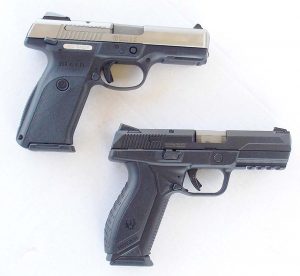
The Ruger American differs considerably from the SR series, top. Both are good handguns but the author prefers the Ruger American.
More recently I proofed the pistol with the Black Hills 124-grain JHP +P. This load breaks well over 1,200 fps from the Ruger American. This is the ideal service load, with a good balance of expansion and penetration. Accuracy results with the pistol are shown in the accompanying table. The Ruger American averaged five-shot groups of three inches or less at 25 yards—service grade accuracy—with this load, from a solid bench rest. Some loads have averaged four inches, which is still acceptable for a practice loading. With only one trigger action to learn and excellent practical accuracy, I would rather have the Ruger American than the Beretta 92 A1 or A3. Handling and safety features make it superior to the Glock. Handgun technology simply advances too quickly to rely upon a 1970s 9mm pistol for service use. Meantime the Ruger American is going to prove a popular pistol with the American public.
Packing the Ruger
During the test I carried the Ruger in an Eclipse Holsters (Eclipseholsters.com) strong side scabbard. I set the adjustable belt attachments for a high ride. Security and speed was excellent—among the best balances of speed and security I have yet encountered. The holster was molded for the Smith and Wesson M and P, but the Ruger is a perfect fit. The belt is from Big Foot Gun Belts (gunbelts.com). This is a service grade combination that will see much use.

